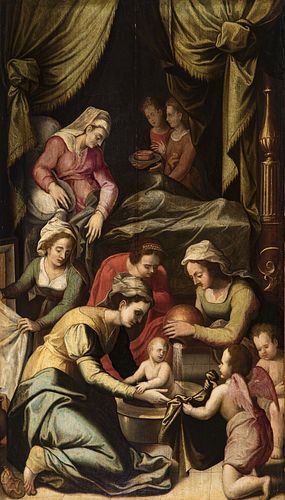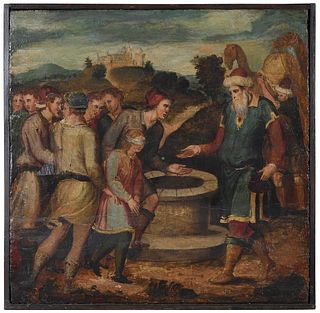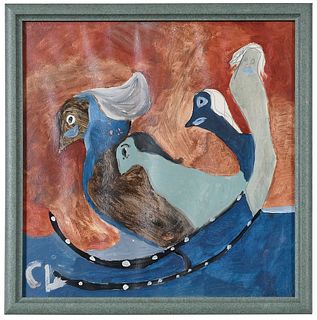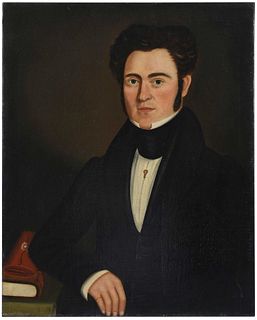Castilian school; XVI century. "The birth of St. John the Baptist". Oil on panel.
Lot 47
About Seller
Setdart Auction House
Carrer Aragó 346
Barcelona
Spain
Setdart Subastas was born in 2004 and is currently the first online art auction in Spain with solidity, prestige and reliability guaranteed by our more than 60,000 users. Setdart has a young, dynamic and enterprising team ready to successfully manage the purchase and sale of art works through custom...Read more
Estimate:
EUR€4,000 - EUR€5,000
$4,301.08 - $5,376.34
Absentee vs Live bid
Two ways to bid:
- Leave a max absentee bid and the platform will bid on your behalf up to your maximum bid during the live auction.
- Bid live during the auction and your bids will be submitted real-time to the auctioneer.
Bid Increments
| Price | Bid Increment |
|---|---|
| EUR€0 | EUR€10 |
| EUR€200 | EUR€25 |
| EUR€500 | EUR€50 |
| EUR€1,000 | EUR€100 |
| EUR€3,000 | EUR€200 |
| EUR€5,000 | EUR€500 |
| EUR€10,000 | EUR€1,000 |
| EUR€20,000 | EUR€2,000 |
| EUR€50,000 | EUR€5,000 |
About Auction
By Setdart Auction House
Nov 3, 2021
Set Reminder
2021-11-03 08:00:00
2021-11-03 08:00:00
America/New_York
Bidsquare
Bidsquare : OLD MASTERS
https://www.bidsquare.com/auctions/setdart-auction-house/old-masters-7786
Setdart Auction House sofia@setdart.com
Setdart Auction House sofia@setdart.com
- Lot Description
Castilian school; XVI century. "The birth of St. John the Baptist". Oil on panel. It conserves frame of epoch. Measurements: 95 x 55 cm; 113 x 73 cm (frame). Rectangular format this piece welcomes the theme of the birth of St. John the Baptist. In the foreground, located in the center, the newborn child is seen being assisted by four women and two small angels. Behind them in the bed, rests the mother, who by her physical features seems exhausted. Finally, the scene is completed by two more figures in the background who seem to be carrying food to the mother. From the features of the woman and the child it can be established that this is the representation of the birth of St. John the Baptist, which took place six months later than the birth of Christ. The biblical story points out that Zechariah and Elizabeth were an old married couple who could not have children. However, one day the angel Gabriel appeared to Zechariah and said, "Fear not, Zechariah, for your request has been heard. Elizabeth your wife will bear a son, and you shall call his name John. He will be to you joy and gladness, and many will rejoice at his birth, for he will be great before the Lord; he will not drink liquor; he will be full of the Holy Spirit, and will turn many to God, and will have the spirit of Elijah the prophet, to prepare for the Lord a people well disposed." Due to the technical characteristics, such as the modeling of the forms, the tonalities used, the type of composition, and even the aesthetic details used for the creation of the nimbus of sanctity, the work presents great similarities with the Castilian school. At the beginning of the 16th century, Castile was one of the places most willing to receive the new humanist concepts of life and art due to its spiritual, political and economic conditions, although from the point of view of the plastic forms, its adaptation of those introduced by Italy was slower due to the need to learn the new techniques and to change the taste of the clientele. The painting reflects this desire to return to the classical Greco-Roman world that exalts the individuality of man in his nudes, creating a new style whose vitality surpasses mere copying. Soon the anatomy, the movement of the figures, the compositions with a sense of perspective and balance, the naturalistic play of the folds, the classical attitudes of the figures began to be valued; but the strong Gothic tradition maintains the expressiveness as a vehicle of the deep spiritualistic sense that informs our best Renaissance sculptures.
- Shipping Info
-
In-house shipping available. Please inquire at admin@setdart.com.
-
- Buyer's Premium



 EUR
EUR CAD
CAD AUD
AUD GBP
GBP MXN
MXN HKD
HKD CNY
CNY MYR
MYR SEK
SEK SGD
SGD CHF
CHF THB
THB

















